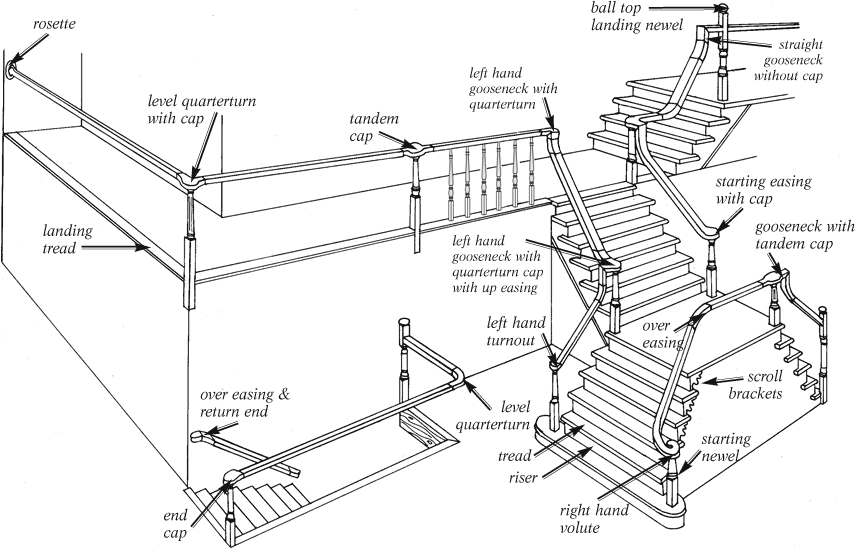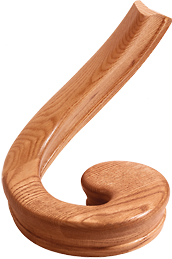Wood Stairs » Product Information » Buying Handrail Fittings
A common question we receive from our customers is how they connect two handrails where they meet at a change in direction or what the “Curly Q” at the start of the stair is called. This in addition to a variety of questions about handrail fittings and what exactly they are. Handrail fittings are those stair parts that are precision manufactured to match the handrail in order to change direction or terminate the rail. There is a wide variety of them to be used in many situations. There are basically two types of fittings, Level and Eased. In each of these two categories there are an additional two types of fittings, transition fittings and termination fittings. In addition, fittings are often used in a series to make more complex transitions or to transition to a termination 🙂 The following diagram shows how many types of fittings are used.
The level fittings include Quarter Turns which are available in several different angles, S-Turn Fittings, Level Volutes and Tandem Fittings. Basically, these are flat fittings as opposed to three-dimensional fittings. They allow a handrail to change direction in the same plane. If this is confusing, here are a couple of examples. Quarter turns are used to connect two handrails that meet at an angle such as 90 degrees or 135 degrees or to returns a rail to a wall or post.
S-Turn Fittings allow a handrail to go around a wall such as in the case of a balustrade transitioning to a wall mounted rail.
Then you have the capped fittings such as tandem caps and quarter turns with caps. This type of fitting is used in an over the post systems that are made to accept Turned Newel Post in the middle of a balustrade or at a corner.
Finally, there are the level termination fittings such as volutes, start caps and turnouts. These fittings are used as a decorative feature to terminate the balustrade. Often these fittings are used with the eased fittings (as shown below) to transition from the stair rail to the volute for example. These add a graceful, welcoming touch to the entryway of a stairway.
Now, I’ve briefly mentioned the eased fittings and shown them in combination above, but let’s look a little closer. These fittings include three basic types, Up Easings, Over Easings and Goose Necks. They allow the handrail to change pitch instead of those described above which only change the angle.
Up Easings are used to make the transition up at an angle between two handrails or a fitting and a handrail, such as transitioning between a flat volute and a stair rail.
Overhand or Over Easings are used for the exact opposite situation. Making the transition down at the angle between to handrails or a handrail and fitting. For example: from a level handrail at the top of a stair to the stair rail below.
Finally, Goosenecks are a combination of an Up Easing with a Rail Drop or a section of the straight handrail that allow for the often drastic transitions that can occur between a lower stair rail and an upper balcony.
Finally, there is one other fitting that deserves notable mention. This is the compound climbing volute. Also known as declining or ascending volutes, these are the most luxurious of fittings. They are used at the start of the stair and curve in a graceful spiral that is the most luxurious and welcoming of handrail fittings available.
As you can see from these few examples there are many variations of Stair Fittings that are made to accommodate most scenarios. As I mentioned they are often used in a series of two or more to make more complex transitions or to transition to a termination. Many of the more common combinations are available for sale in sets.
